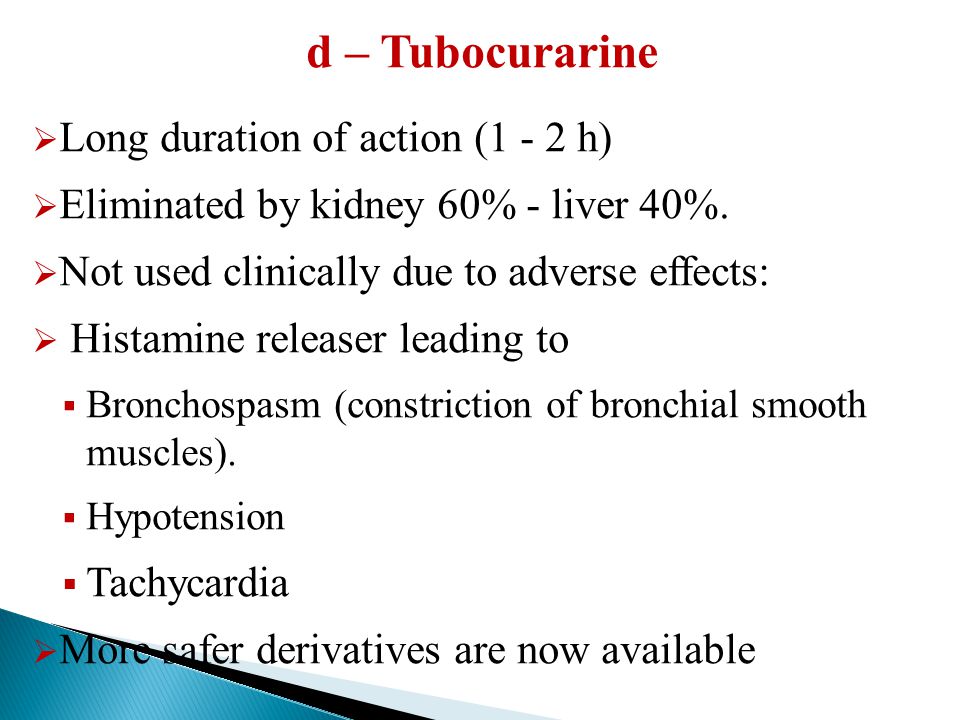D Tubocurarine Action
Sodium channels in the muscle fibre. Tubocurarine chloride competes with acetylcholine for the nicotinic receptors at the neuromuscular junction of skeletal muscles thereby inhibiting the action of acetylcholine and blocking the neural transmission without depolarizing the postsynaptic membrane.

Mechanism Of Action Of Non Depolarizing Blockers Download Scientific Diagram
The issue of whether d-tubocurarine the classical acetylcholine receptor inhibitor inhibits the receptor by a competitive or noncompetitive mechanism has long been controversial.

D tubocurarine action. Of the nondepolarizing neuromuscular blockers d-tubocurarine causes the most histamine release by a direct effect on mast cells. This results the skeletal muscle relaxation. D-Tubocurarine is an antagonist of works against the nicotinic acetylcholine receptor.
It derives from a hydride of a tubocuraran. C 7. Drugs that bind to nicotinic cholinergic receptors RECEPTORS NICOTINIC and block the actions of acetylcholine or cholinergic agonists.
Sodium channels in the muscle fibre ANSWER. Mechanism of Action of D-tubocurarine. 3 noted divergence of the eyes following the use of a muscle relaxant in anesthetized patients.
At the muscle end-plate d-tubocurarine reduces the A. Tubocurarine is used in surgical practice as a muscle relaxant. Click to see full answer Then how does D Tubocurarine work.
B 6. ThepotencyoftheDTCwascheckedbyits effectiveness in blockiing neuromuscular transmission. At that time it was known that curare and therefore d-tubocurarine worked at the neuromuscular junction.
D tubocurarine mechanism of action Skip Nav Destination Br J Anaesth 2001. Spinal internuncial neurone B. D-Tubocurarine chloride is a powerful drug and its use is only justified if anequally powerful antidote is immed-iately available.
Kg-1 induced a significant decrease in mean blood pressure from 97 6 to 53 11 and a significant increase in heart rate from 79 10 to 99 6 beatsmin. 75569 Since the introduction of tubocurarine dTc45 many new neuromuscular blocking NMB agents have been brought into anaesthesia practice. The use of d-tubocurarine to produce akinesia of the extraocular muscles during surgery was pioneered in this country by Kirby.
Duration for which the Na channels remain open. Effects o f d-tubocurarine Intravenous administration of d-tubocurarine 0200 mg. Spinal internuncial neurone B.
DTC acted as an antagonist of ACh for activation of adult-type receptors whereas it acted as a weak partial agonist at fetal-type receptors. The nicotinic acetylcholine receptors form ion-channels and are activated by acetylcholine and nicotine just as the name indicates. D-tubocurarine is a long acting.
Tubocurarine acts as a competitive inhibitor in the nicotinic acetylcholine receptor meaning that the nerve impulse is blocked by this alkaloid. The mechanism of action is all that is left to explain. Action ofphysostigmine andneostigmine as anti-dotes to d-tubocurarine chloride.
Competitive neuromuscular blocker competes with acetylcholine for receptor sites at the motor end plate thereby reducing the response of the end plate to acetylcholine. The action ofphysostigmine wasfirst observed byPall. These alkaloids have an observably large spectrum of activity and possible applications.
Fortunately we have in physo-stigmine and neostigmine that antidote. Resistance to d-Tubocurarine of the Rat Diaphragm as Compared to a Limb Muscle. 2 Lincoff et al.
Tubocurarine the chief alkaloid in tobacco products binds stereo-selectively to nicotinic-cholinergic receptors at the autonomic ganglia in the adrenal medulla at neuromuscular junctions and in the brain. Motor nerve ending C. Motor nerve ending C.
D-Tubocurarine in this study has been found to be both a competitive KC 120 nM and. It has a role as a nicotinic antagonist a muscle relaxant and a drug allergen. Two types of central nervous system effects are.
Tubocurarine is a benzylisoquinoline alkaloid muscle relaxant which constitutes the active component of curare. DTC 5 x 10-6 Iq placed in the bath blocked all. Nicotinic antagonists block synaptic transmission at autonomic ganglia the skeletal neuromuscular junction and at central nervous system nicotinic synapses.
Influence of Quantal Transmitter Release and Nicotinic Acetylcholine Receptors Anesthesiology May 2009 Prolonged d-Tubocurarine Infusion andor Immobilization Cause Upregulation of Acetylcholine Receptors and Hyperkalemia to Succinylcholine in Rats. The site of action of d-tubocurarine is. Tubocurarine a naturally occurring alkaloid is used to treat smoking withdrawl syndrom.
D-Tubocurarine chlorile DTC Burroughs-Wellcome crystalline was applied to the whole muscle and unless otherwise noted in the text it was allowed to act for at least. This may lead to skeletal muscle relaxation and paralysis. The site of action of d-tubocurarine is A.
Tubocurarine is a non-depolarizing neuromuscular blocking agent and the first identified curare alkaloid. Currents were elicited by acetylcholine ACh by d-tubocurarine dTC and by mixtures of ACh and dTC from stably transformed fibroblasts that express fetal or adult muscle nicotinic receptors. D-tubocurarine a mono-quaternary alkaloid was isolated from Chondrodendron tomentosum in 1942 and it was shown to be the major constituent in curare responsible for producing the paralysing effect.
Histamine release can cause bronchospasm hypotension salivary secretions. Number of Na channels B.

Skeletal Muscle Relaxants Dr Naser Ashraf Types Of Skeletal Muscle Relaxants 2 Groups Neuromuscular Blockers Relax Normal Muscles Surgery And Assistance Ppt Download

Skeletal Muscle Relaxants By S Bohlooli Ph D

Skeletal Muscle Relaxants Ppt Download
Posting Komentar untuk "D Tubocurarine Action"